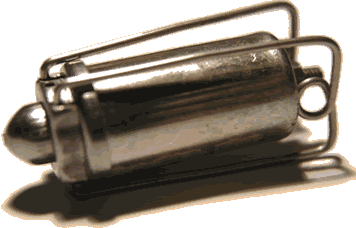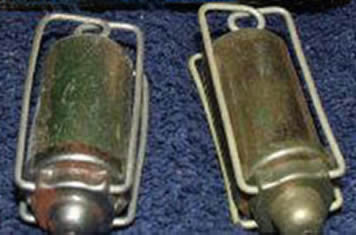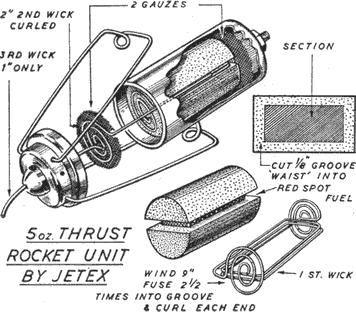Jetex 50R/50HT


 Jetex/Aristocraft 50HT
Jetex/Aristocraft 50HT
- Ben Nead



 A pair of Jetex 50Rs
A pair of Jetex 50Rs
- Ron Shain



 Loading diagram for the Jetex 50R
Loading diagram for the Jetex 50R
- Aeromodeller, April 1955
|
 |
This boosted-thrust dual-spring motor was introduced by Wilmot Mansour in 1955 and marketed in the UK and British Commonwealth countries as the 50R (‘R’
signifying ‘rocket’). It was brought to the US market by Telasco in 1963 as the 50HT (‘HT’ signifying ‘high thrust’).
The 50R/50HT used Red Spot fuel (‘HT’ fuel in the US), prepared in such a way that it burned at a much faster rate than in the 50C, thus achieving significantly higher thrust – 5-6 oz for up to 4 seconds was claimed. It was essentially a modified 50B/C, with a slightly larger orifice, and two springs to cope with the higher internal pressures. Attachment to the model was by a short 6 B.A. threaded stub at the front. The 50R came with a neat wooden jig and a ratstail file to facilitate cutting grooves in the propellant. In the US, fuel for the 50HT had a ¹/8" hole drilled through the pellet (see Paul Del Gatto’s review).
Both the 50R/50HT and the dual spring Scorpion 600 were deliberate attempts by the Jetex manufacturers to
cash in on the then-new model rocketry phenomenon. The 50R was marketed in conjunction with the Jetex ‘Dan Dare’ Space Ship, which required sufficent power for vertical
launching and contained a dethermaliser timer that deployed a parachute to cushion the landing. Simpler applications found the motors adapted to featherweight rocket
models lacking any form of landing assistance. In the US, the
Estes black powder motors introduced in 1960 (with their very effective built-in
timed nosecone-popping deployment charge and true electronic
remote firing off the launch pad) proved to be a far more practical
choice for flying model rockets. It was only in the UK (where Estes motors
were not available until the 1980s) that the 50R/50HT and Scorpion 600 were
commonly used for elementary model rocketry.
It was old stocks of the 50R that were marketed by Powermax as the ‘Jet-X 50’ in the latter part of 1980s (together with some remaining examples of the single spring Aristocraft 50C ‘Hellcat’). The 50R motors worked well and delivered a thrust well up to 50C specifications when fuel pellets were ignited from one end only. This motor and supplies of fuel stimulated a Jetex revival at that time, which lasted while old cases and stocks of original pellets remained available.
While some will laud the 50R/HT as an innovative departure, it is perhaps better considered as a blind alley in the Jetex lineage – an ill-advised attempt to shoehorn an
existing product, which was unique and behaved like no other reaction motor,
into a rather pedestrian role, attempting to make it behave like any
other garden variety short duration rocket motor.
|